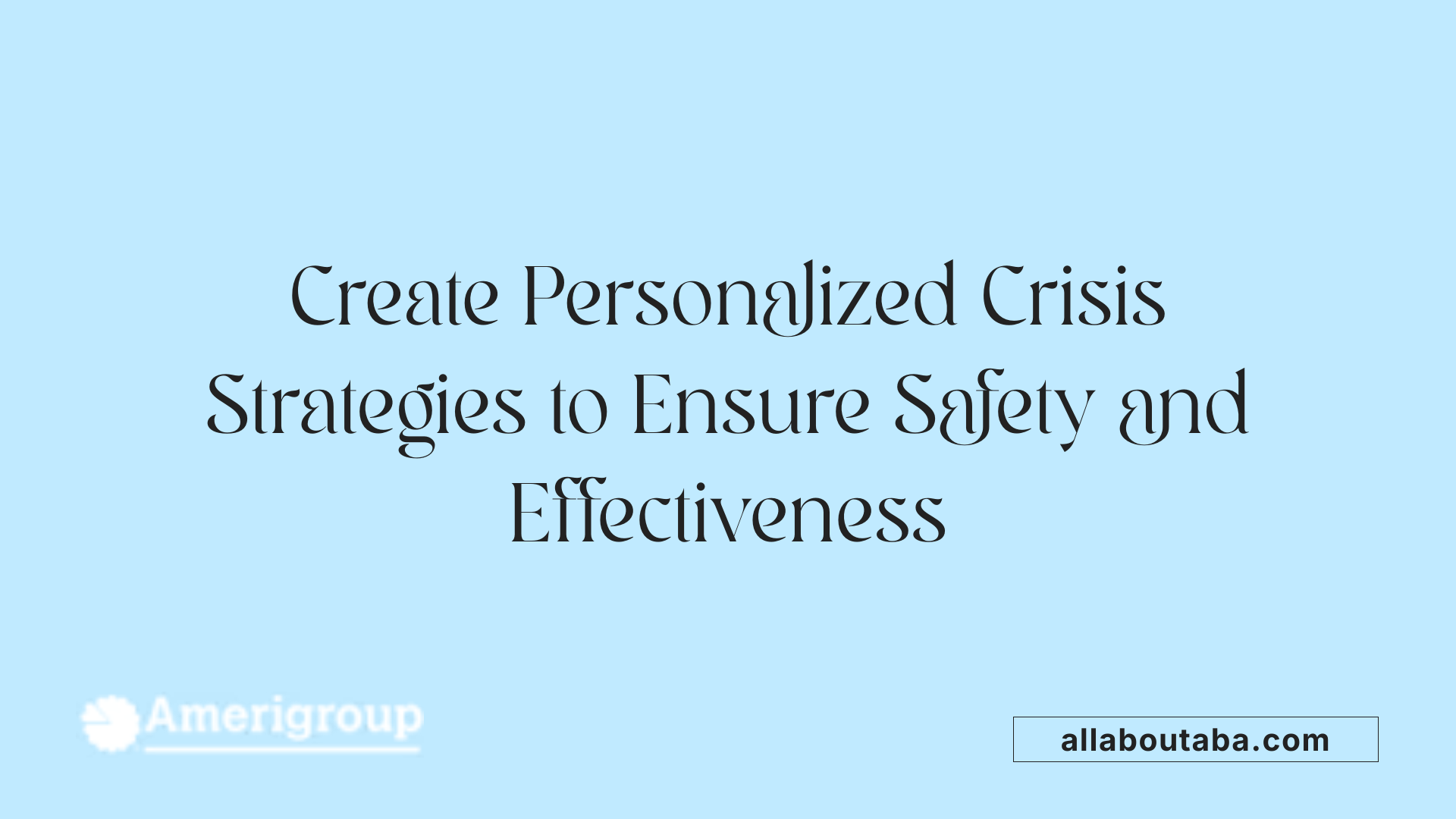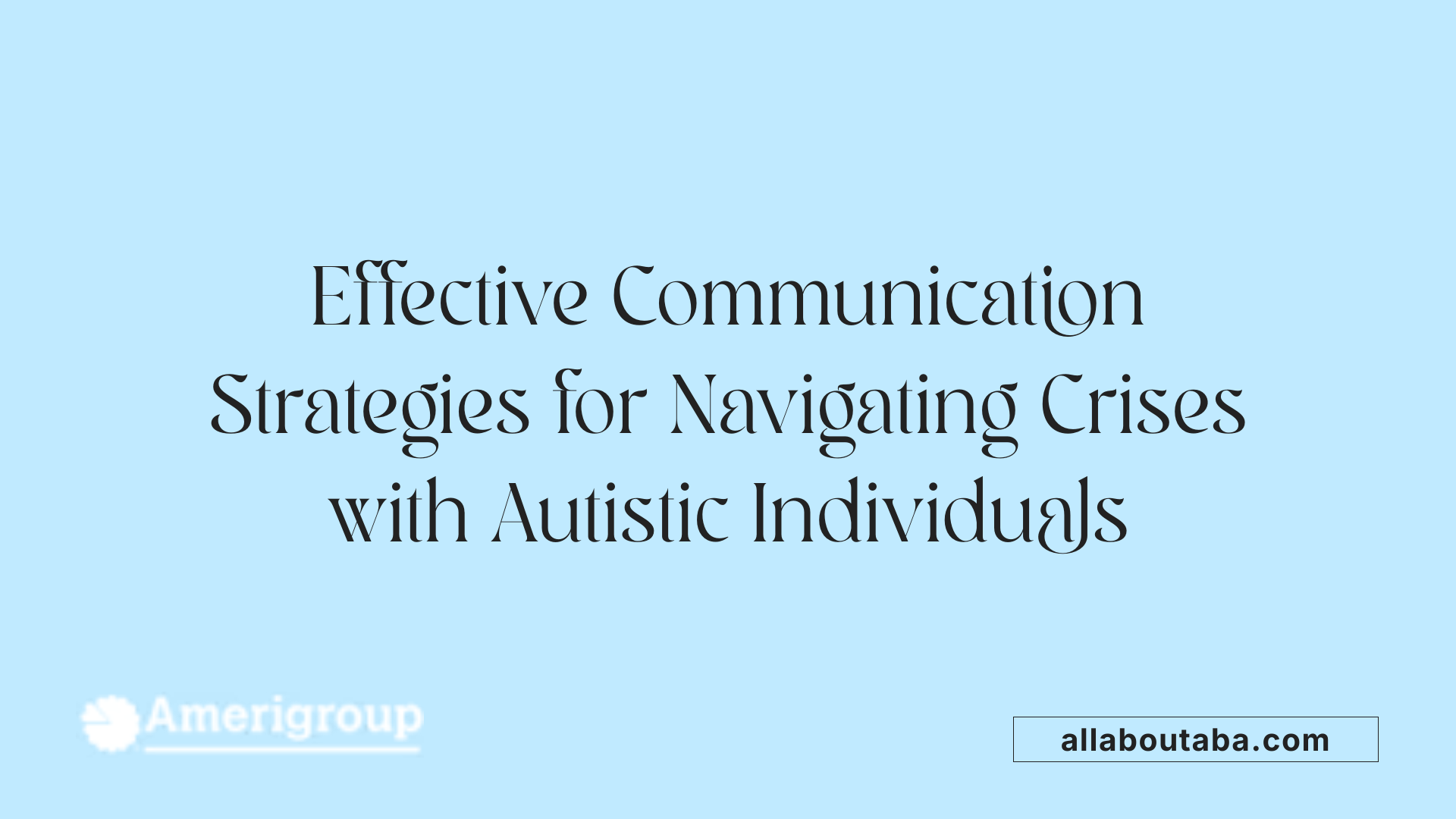Understanding Crisis in Autism
Crisis situations involving autistic individuals are complex and require specialized support. Understanding the nature of autistic behaviors during escalation, the role of tailored intervention strategies, and the importance of individualized crisis planning can greatly enhance safety and outcomes. This article explores essential approaches and therapeutic frameworks that guide caregivers, professionals, and communities in effectively supporting autistic individuals through crisis.
Developing and Implementing Individualized Crisis Plans

Why Are Personalized Crisis Plans Important?
Personalized crisis plans are essential because they take into account an individual's unique history, needs, and behaviors. For autistic individuals, recognizing specific triggers and understanding their communication style helps prevent escalation and enhances safety during crises.
How Do You Identify Triggers and Warning Signs?
Identifying triggers involves observing environmental factors, social situations, or sensory inputs that cause distress. Warning signs are early behavioral or emotional cues indicating rising tension. These could include unusual speech patterns, perseveration on certain thoughts, or changes in mood.
What Should Intervention Steps and Safety Procedures Include?
Effective crisis plans must outline clear intervention steps that prioritize safety over behavior correction during full meltdowns. Strategies include reducing stressors, maintaining calmness, giving personal space, providing simple instructions, and using calming activities or objects. Safety procedures should be customized for each person's needs and include data collection methods to monitor progress and evaluate effectiveness.
Why Is Training Caregivers and Staff Vital?
Training equips caregivers and staff with the skills to recognize triggers, implement tailored intervention strategies, and follow safety protocols confidently. Practice ensures preparedness in managing crises compassionately and effectively. Additionally, knowledge of facility emergency procedures and guardianship arrangements is crucial, especially for individuals over 18, to ensure legal and safety measures are in place.
Recognizing and Managing Meltdowns and Shutdowns

What Behavior Occurs During Full Meltdowns?
During a full meltdown, a child is typically unable to reason or follow redirection. This means they are overwhelmed and cannot control their reactions through typical calming or corrective measures. Recognizing this helps caregivers prioritize safety over behavior correction.
Why Is Prioritizing Safety Important?
Because the child cannot process instructions during a meltdown, ensuring a safe environment becomes the most critical step. Focus shifts from trying to change the behavior immediately to preventing harm to the child and people around them.
What Strategies Help Calm Escalating Situations?
Calming an escalating situation involves reducing stressors, maintaining a calm demeanor, and giving the individual physical space. Providing simple, clear instructions and engaging calming activities or objects can also help de-escalate tension.
How Should Emotional Expressions During Crisis Be Understood?
Autistic individuals may express emotions in ways that don’t match their internal experience, such as laughing when distressed. Understanding these atypical emotional expressions is crucial for interpreting their needs correctly and responding with empathy and patience.
Communication Challenges and Support Techniques in Crisis

Literal Thinking and Need for Clear Communication
Autistic individuals often engage in literal thinking, which means they interpret language exactly as it is said. This trait requires support workers and caregivers to communicate using precise, straightforward language. Avoiding metaphors, idioms, and social nuances is crucial to prevent misunderstandings during a crisis.
Difficulty Identifying and Verbalizing Emotions
Many autistic people struggle to recognize or express their emotions, a difficulty sometimes linked to alexithymia. This can make emotional distress harder to understand and manage. Patience and tailored communication strategies, such as using simple, concrete language and allowing additional processing time, help address this challenge effectively.
Use of Direct Questions and Patience in Support
When providing crisis support, asking clear and direct questions is essential. Autistic individuals benefit from time to process information; rushing can increase stress. Caregivers should maintain a calm demeanor, speak slowly, and allow pauses, ensuring the individual feels understood and supported rather than overwhelmed.
Interpreting Atypical Speech and Behaviors
Some autistic people display unusual speech patterns—such as odd pitch, tone, robotic pacing, or echolalia—which are part of their communication style. Additionally, expressions like laughing during distress can seem contrary to their internal feelings. Recognizing these behaviors as meaningful forms of communication helps prevent misinterpretation and guides effective intervention.
Applied Behavior Analysis (ABA) Therapy: Principles and Benefits

What is Applied Behavior Analysis (ABA) therapy?
Applied Behavior Analysis (ABA) therapy is a science-driven approach focused on understanding and improving behaviors. It involves increasing helpful behaviors such as communication, social skills, and self-care, while decreasing behaviors that may cause harm or disruption. ABA uses the A-B-C model — Antecedent-Behavior-Consequence — to analyze what triggers a behavior and the outcomes that reinforce it. By structuring specific interventions, tracking progress with data collection, and tailoring strategies to each individual's needs, ABA offers personalized support to foster meaningful skill development.
What are the common techniques used in ABA therapy?
ABA therapy employs several tried-and-true methods:
- Discrete Trial Training (DTT): A step-by-step approach where skills are taught through repeated, structured trials with positive reinforcement.
- Natural Environment Teaching (NET): Skills are taught within everyday routines and social play to promote generalization.
- Behavior Chaining: Complex tasks are broken into smaller, teachable steps.
- Prompting and Fading: Helps the individual develop independence by gradually reducing assistance.
- Positive Reinforcement: Rewarding desired behaviors to encourage repetition.
- Extinction: Reducing attention to problematic behaviors to diminish them.
- Visual Modeling: Use of pictures or videos to demonstrate behaviors for imitation.
These techniques are adjusted to fit the individual's goals and developmental level.
How does ABA therapy benefit individuals with autism?
ABA therapy helps people with autism by teaching vital skills that improve independence and quality of life. Through positive reinforcement and data-driven strategies, ABA encourages effective communication, social engagement, and daily living skills. Children receiving ABA often make significant developmental progress, enabling better participation in school and community activities. As an evidence-based method, ABA offers a structured yet flexible framework that addresses unique challenges while promoting emotional regulation and social inclusion.
At what age can a child begin ABA therapy?
ABA therapy can begin very early, even around 6 months for high-risk infants. Typically, children start between ages 2 and 6, especially following an autism diagnosis. Early initiation, particularly before age four, is linked to better outcomes in language, behavior, and adaptive skills that can persist into adulthood. While early childhood is ideal, ABA can be adapted and started at any age, including adolescence and adulthood, to meet ongoing developmental needs.
Data-Driven Progress Monitoring and Team Collaboration in ABA

Use of Systematic Data Collection
Applied Behavior Analysis (ABA) therapy employs systematic data collection to track the progress of individuals with autism. This involves continuous recording of behavioral metrics such as frequency, duration, and intensity of targeted behaviors. The data enables therapists to analyze the effectiveness of interventions and make informed adjustments. Maintaining accurate and timely data supports objective measurement of progress and helps identify patterns that guide treatment planning.
Behavioral Metrics and Analysis
Behavioral metrics in ABA focus on observable and measurable behaviors. Analysis includes evaluating antecedents, behaviors, and consequences to understand function and inform treatment modification. Regular review sessions utilize data charts and graphs that visually present progress toward goals. This empirical approach ensures that behavioral interventions are evidence-based and tailored to the individual’s evolving needs.
Role of Professionals and Caregivers
ABA therapy is typically provided by licensed professionals such as Board Certified Behavior Analysts (BCBAs), Board Certified Assistant Behavior Analysts (BCaBAs), and Registered Behavior Technicians (RBTs). BCBAs hold master’s degrees and are responsible for designing, supervising, and modifying individualized treatment plans. BCaBAs assist BCBAs, supervise RBTs, and help with data collection, while RBTs implement therapy sessions and collect data under supervision. Paraprofessionals may provide support but do not develop or change plans unless qualified. Caregivers play a crucial role by supporting consistency, reinforcing learning at home, and collaborating closely with the therapy team to ensure goals align with daily needs.
Importance of Team Training and Ethical Standards
Effective ABA therapy requires ongoing training for all team members, including caregivers, to ensure proper implementation and fidelity to protocols. Ethical standards guide professional conduct, prioritizing the individual’s dignity, well-being, and rights. Teams regularly engage in professional development to stay current with best practices and maintain a supportive, informed environment conducive to success.
| Aspect | Description | Importance |
|---|---|---|
| Data Collection | Continuous recording of targeted behaviors | Provides objective evidence for treatment decisions |
| Behavioral Metrics | Frequency, duration, antecedent-behavior-consequence analysis | Identifies behavioral functions and tracks intervention impact |
| Professional Roles | BCBAs (clinical leadership), BCaBAs (assist/supervise), RBTs (therapy delivery), Caregivers (support) | Ensures tailored intervention and consistent implementation |
| Training & Ethics | Ongoing education, adherence to ethical guidelines | Maintains treatment quality and protects individual rights |
Addressing Sensory and Emotional Challenges in Crisis
How Do Sensory Processing Difficulties Affect Crisis Situations?
Many autistic individuals experience sensory processing challenges, making ordinary environmental stimuli feel overwhelming. Overstimulation can lead to increased stress, impacting behavior and communication during a crisis. Recognizing signs such as unusual speech patterns or echolalia can aid in adjusting support strategies accordingly.
What Is Catastrophising and How Can Anxiety Be Managed?
Catastrophising involves rapidly spiraling thoughts toward worst-case outcomes, common among autistic people with high anxiety levels. This tendency, though often based on unlikely scenarios, feels very real to the person experiencing it. Effective support includes acknowledging these fears without dismissal, offering fact-based reassurance, and breaking down fears into manageable parts.
What Strategies Help Reduce Stress During Crisis?
Calming an escalating situation can involve:
- Minimizing environmental stressors
- Maintaining a calm demeanor
- Providing clear, simple instructions
- Giving the individual physical space
- Offering calming objects or activities These approaches respect the individual's sensory sensitivities and communication needs.
Why Are Self-Regulation Skills Important?
Teaching coping strategies, tolerance for delay, and daily living skills empowers autistic individuals to manage stress better and enhances autonomy. Post-incident debriefs help improve self-awareness of triggers and strengthen regulation skills for future challenges, reducing the intensity and frequency of crises.
Post-Crisis Support and Enhancing Future Resilience
Why is post-incident debriefing important?
Post-incident debriefing is crucial for both the individual and support team as it helps deepen understanding of what triggered the crisis and the behaviors involved. This reflection enhances future self-regulation strategies and prepares everyone better for similar situations.
How can understanding triggers and behaviors improve future responses?
By analyzing triggers and behavioral responses after a crisis, caregivers and individuals can tailor prevention and intervention strategies effectively. This understanding is fundamental for reducing the frequency and intensity of future crises.
In what ways can boosting self-esteem and coping strategies aid recovery?
Following a crisis, focusing on boosting self-esteem helps counteract feelings of self-blame and rejection that often arise. Teaching positive coping strategies empowers individuals to manage overwhelming emotions, improving resilience against future stressors.
Why is building supportive relationships and community integration crucial?
Supportive relationships alleviate feelings of isolation common in autistic individuals. Community integration fosters connectedness and acceptance, reducing social rejection and its related crisis triggers. These bonds provide ongoing emotional support and enhance quality of life.
Empowering Support Through Knowledge and Compassion
Supporting autistic individuals in crisis requires a comprehensive understanding of their unique needs, communication styles, and behavioral patterns. By developing personalized crisis plans, employing evidence-based therapies like ABA, and fostering effective communication, caregivers and professionals can minimize harm and promote positive outcomes. Attention to sensory sensitivities, emotional regulation, and post-crisis support further strengthens resilience and well-being. Ultimately, compassion combined with specialized strategies creates safer environments where autistic individuals can navigate crises with dignity and support, empowering them toward greater independence and inclusion.
References
- Planning for a crisis
- Treatment for Behavioral Issues in Autism
- Crisis Supports for the Autism Community
- Autism and catastrophising
- Treatment and Intervention for Autism Spectrum Disorder
- Applied Behavior Analysis (ABA)
- Applied Behavior Analysis (ABA)
- What Is Applied Behavior Analysis (ABA)?
- Applied Behavior Analysis (ABA)
- The Top 10 Reasons Children With Autism Deserve ABA







